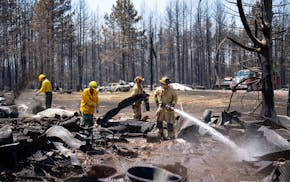Opinion editor's note: Strib Voices publishes a mix of commentary online and in print each day. To contribute, click here.
•••
Last Friday, President Donald Trump announced support for a $14 billion partnership between U.S. Steel and Nippon Steel of Japan. The word "partnership," of course, dresses up the reality that this is the very merger Nippon and U.S. Steel sought these past 17 months. Nearly killed on the grounds of national security, election-year politics and archaic views of our Japanese allies, the deal has sprung back to life.
Somehow the news brought back memories of my first job at Snickers Pizza in the Iron Range town of Eveleth, Minn. One night, as the bar crowd shuffled out at closing time, a drunk said to the cook, "Make me a pepperoni pizza." The cook said, "Poof, you're a pepperoni pizza." Everyone had a laugh, and the wordplay prevented us from having to restart and reclean ovens.
Trump bragged that the company would still be called U.S. Steel, that its headquarters would remain in Pittsburgh, and that Nippon would be modernizing the company's aging infrastructure. This includes two iron ore plants in Minnesota employing a total of 1,800 people.
But Nippon had already proposed all that from the beginning.
This stunning turnaround, cloaked in the dawning hours of a long holiday weekend, deserves inspection. It's not that the decision was wrong. It might be the best of a few flawed options. But the sudden shift in rhetoric reflects the chaos that can turn even progress into open-ended anxieties, and everything into an opportunity for influence-peddling and grift.
Let's start with the good. A deal like this was necessary for the long-term survival of U.S. Steel. It floods the company with a $14 billion investment, including several billion to upgrade aging blast furnaces in Pennsylvania and Indiana.
These improvements are crucial to the continued operation of Minnesota iron mines, which still produce traditional taconite for blast furnaces. Systemic change is needed because the steel industry is rapidly shifting to low-carbon steel production and electric arc furnaces, which use pure iron and scrap steel.
The investment will also upgrade Minnesota mines — including Minntac in Mountain Iron and Keewatin Taconite, which need improvements to make value-added iron products to feed the new technology. This won't necessarily create new jobs, but it will likely extend the life of mines here and the 1,800 jobs U.S. Steel currently provides Minnesotans.
The deal comes with risk, however, which is why some see it as bad. The United Steelworkers of America fought the Nippon merger with every ounce of the union's political capital. They had hoped to force U.S. Steel into a deal with Cleveland-Cliffs, an American company with which they've enjoyed a friendlier relationship.
The union gets nothing. Both they and Cliffs emerge weakened from this deal. The 700 iron mining layoffs on the Range are entirely at Cliffs facilities. Some workers fear that the closure at the Minorca mine near Virginia, Minn., might be long-term or even permanent.
And then there's the ugly. Why did Trump change his mind? And why are so many of his supporters pretending that they, too, were just pretending when they said the deal with Nippon was unacceptable?
Trump essentially adopted the opposite position he took a few months ago and pretended it was the position he had all along. Supporters might ascribe this to some mysterious wisdom I couldn't possibly comprehend, but I see two more likely reasons:
- Trump and his people were told that U.S. Steel plant closures and layoffs were imminent and had to sell a retreat as some kind of victory. This would be a good reason to change one's mind, but not one that suggests a strong economy.
- Trump and his people were convinced in some other way. I'd highlight the porous channels of backdoor donations, money transfers and preferential trade deals that appear to represent the administration's day-to-day operating system. We may never know how this or any other foreign trade deal is being influenced in this way.
I suppose we may find some solace that something so ugly could produce something potentially good, especially if it preserves high-paying jobs in an economically stressed part of Minnesota. But government by whim takes more than it gives in the long run. This deal could have been improved and approved long ago had Trump, former President Joe Biden and other political actors considered the big picture instead of electoral consequences.
For instance, we don't know exactly how much investment will be made in Minnesota's mines, nor do we have assurances of what the iron industry really needs. This could have been negotiated.
To maintain its relevance in the steel industry, the Iron Range region needs the low-grade ore we currently mine to become part of value-added iron and steel production. So long as we're wedded to blast furnaces, the end of Range iron mining will come sooner than desired.
As it is, a lot of people voted for Trump to keep U.S. Steel American-owned. It's fun to pretend that this is what just happened, but pretending won't solve real problems in the legacy industries so many Americans count on.

Brown: As once-giant Joann Fabrics shutters its doors, the DIYers must sew our economy back together

Brown: How little fish and secret mushrooms can salve Minnesota's culture wars
Brown: The importance of 'the Importance of Sleep'

